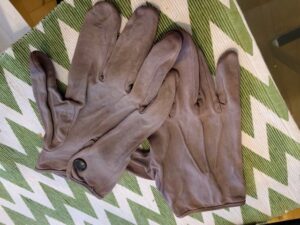 Walt Disney put white gloves on Mickey Mouse when he made The Opry House in 1929. Those big white gloves stop at the wrist and fasten at the back with a button. They have those distinctive three stitch lines that radiate from the fingers tapering to the wrists on Mickey Mouse.
Walt Disney put white gloves on Mickey Mouse when he made The Opry House in 1929. Those big white gloves stop at the wrist and fasten at the back with a button. They have those distinctive three stitch lines that radiate from the fingers tapering to the wrists on Mickey Mouse.
AG sent me a similar pair of men’s gloves in gray. They’re not designed for the cold weather, made of rayon, a semi synthetic fabric approximating silk. Dating the invention of rayon is important to our dating of the gloves. Rayon, discovered in France in the mid-19th century, finally came to America in 1911. That puts AG’s gloves at the 19-teens.
Gloves Integral to a Man’s Wardrobe
Today we don’t think about gloves on a man unless it’s COLD. Although some gloves worn during the pandemic served a hygienic purpose, true in former decades as well. But in the 17th, 18th, 19th, and even early 20th century, gloves on gentlemen appeared de rigueur. Society considered it unseemly for a gentlemen’s bare hand to touch a lady. Not only for decorum, but for hygiene. Gloves provided a protective layer in dirty cities. Remember the late 19th and early 20th century saw the discovery of bacteria and GERMS. This was the era of white and light colors to symbolize cleanliness. White tiled baths became the fashion in this era.
Men’s GLOVES represented the two main themes of the late 19th and early 20th century: sexuality, and hygiene. I learned a lot from Vintage Dancer, the website about anything vintage clothing. Mickey wasn’t the only male wearing gloves in 1929.
Two Categories of Men’s Gloves
They wore day or street Gloves, and evening gloves. The highly sociable, upper class American and British man of the late 19th and early 20th century conducted his day without working at a job as we do. He went to the bank, church, his club, the library, restaurants, and for these occasions he wore day gloves. Of course, because of the concern for cleanliness, one never found a trace of dirt on a gentleman’s glove. They came in tan, cream, and gray colors with those classic three lines of top stitching.
After 1910 popularity the metal snap replaced the classic pearl button. The short gloves stopped at the wrist. Upper class men in England and US wore gloves of the finest leather, always a perfect snug fit. Gray and black gloves matched black polished shoes.
Vintage Dancer Describes Evening Gloves
In 1900-1920 a man invited to an evening affair, such as a dance, wore white evening gloves. These white goatskin leather gloves prevented a sweaty hand on a lady while dancing (horrors), or worse, a bare touch.
In the 1930s a new fashion came along for men’s gloves in very formal situations such as state weddings. Light gray gloves of washable goatskin. If a man received an invitation for a black or white tie event, then it was expected that he wear white gloves.
The premier glove company of perhaps all-time made AG’s gloves, his ancestor’s. The label, as well as the lettering on the snap, say “Fownes Make.” John and Thomas Fownes established Fownes Brothers and Company in 1777 in the British City of Worcester.
The company opened a sales office in NYC in 1887, their global headquarters, located on Broadway. In 1903 the company opened US factories in Gloversville and Amsterdam, NY. In the 1950s, ahead of its time, the company opened factories in Asia, with an office in Shanghai 2002. Fownes and Brothers is still privately owned with over 3,000 workers. They still set the pace and have two innovative divisions. U/R Powered, creates touchscreen gloves and interactive headgear. Another division focuses on conductive leather and fabrics.
I myself got lucky one day and found my favorite pair of gloves at Goodwill, Fownes made in leather with oh so warm cashmere lining. Might have cost $100 or more at retail. I paid $5. AG’s men’s 1911 gloves are valued at $25.